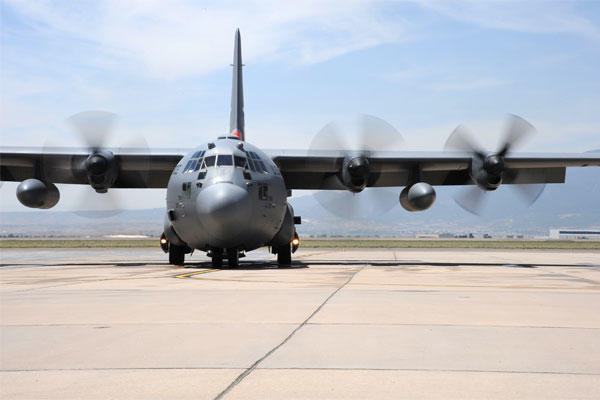BOISE, Idaho -- The U.S. Forest Service, through the National Interagency Fire Center here, has directed the repositioning of military Modular Airborne Fire Fighting System aircraft from Colorado Springs, Colo., to Mesa, Ariz.
"The weather and progress on the ground have helped us in the Four Corners region," said Col. Charles D. Davis III, the commander of the Air Expeditionary Group (Provisional) - Wildland Fire Fighting. "By (July 10), we plan to have relocated all four airplanes and their crews to Arizona."
One MAFFS aircraft departed Colorado Springs July 8 to drop fire retardant on the Dean Peak fire, a wildland blaze burning east of Kingman, Ariz., in an effort to draw suppression lines and help contain the fire.
The AEG intends to have all four MAFFS aircraft ready to make drops in Arizona July 10. They will operate from Phoenix-Mesa Gateway. Two aircraft are from the Air Force Reserve Command's 302nd Airlift Wing, and two are from the California Air National Guard's 146th AW.
"The relocation of the MAFFS resources does not mean MAFFS aircraft will be unavailable should they be needed in the region again if the USFS determines that is necessary," Davis said.
Four additional MAFFS-capable C-130s are operated by Air National Guard units in North Carolina and Wyoming and can be called on if needed.
MAFFS initially activated June 11 to assist in fighting forest fires in Southern Colorado after USFS officials sent a request for assistance to the Department of Defense though U.S. Northern Command. USFS requested two additional MAFFS tankers June 21. Since activating, MAFFS aircraft have made 70 drops on Colorado and Arizona fires using some 190,000 gallons of fire retardant.
MAFFS is a self-contained aerial firefighting system owned by the USFS. MAFFS modules are loaded into the cargo bays of military C-130 aircraft. Following USFS lead planes, military aircrews can discharge 3,000 gallons of water or fire retardant from the MAFFS modules along the leading edge of a forest fire in less than five seconds, and cover an area a quarter of a mile long by 100 feet wide. Once the load is discharged, ground crews at a MAFFS tanker base can refill the modules in less than 12 minutes.
A joint DOD and USFS program, MAFFS provides aerial firefighting resources when commercial and private air tankers are no longer able to meet the needs of the USFS. The military AEG exercises control over MAFFS resources at the direction of the USFS.
Four C-130 units perform the MAFFS mission, each providing two MAFFS-capable aircraft, and the air and ground crews needed to operate them. They are the North Carolina Air National Guard's 145th AW; California ANG 146th AW; Wyoming ANG 153rd AW; and the Air Force Reserve Command's 302nd AW, in Colorado.
The Colorado- and California-based units are currently activated.
USNORTHCOM is the joint combatant command formed in the wake of the Sept.11, 2001, terrorist attacks to provide homeland defense and defense support of civil authorities. USNORTHCOM provides DOD capabilities for disaster response operations in support of the Department of Homeland Security, Federal Emergency Management Agency, National Interagency Fire Center, and state and local officials.


























